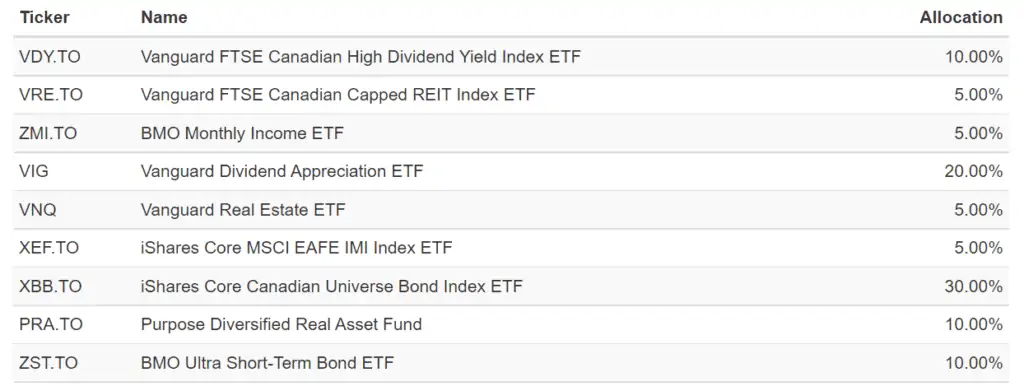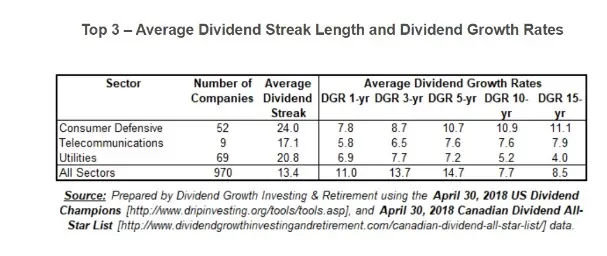By Bob Lai, Tawcan
Special to Financial Independence Hub

Recently I wrote about what we’re doing in this bear market condition. Since we’re still in our accumulation phase, we’re following our investment strategy by continuing buying dividend stocks and index ETFs regularly and building up our dividend portfolio.
But what if you’re closer toward retirement or already retired? How do you protect yourself from the bear market so make sure you can sustain your expenses in retirement? What is the ideal retirement portfolio for Canadian? Should someone simply try to aim to build a dividend portfolio and live off the dividends? To answer this complicated question, I thought it’d be best to ask an expert. So I decided to reach out to Dale Roberts to talk about the retirement portfolio for Canadians.
For those who don’t know Dale, he is a former investment advisor and trainer with Tangerine. He now runs Cut The Crap Investing and is a regular contributor to MoneySense.
Please take it away Dale!
Thanks Bob.
The typical retirement is likely a thing of the past. Yours will not be your Mom and Dad’s retirement and it certainly won’t look much like Grandpa’s either. The traditional model of a workplace pension plus Canada CPP (Canada Pension Plan) and Old Age Security payments plus home equity won’t likely get the job done.
In previous generations many would work until age 65 and with life expectancy in the mid to upper 70s, the retirement was short lived, meaning that long-term inflation was not the threat it is today. And those workplace pensions were commonplace. A retiree could sit back knowing those cheques were coming in on a regular basis, and those pension amounts were often adjusted for inflation.
According to Statistics Canada the Life expectancy in Canada has improved considerably. Women’s life expectancy at birth has increased from 60.6 years in 1920–1922 to 83.0 years in 2005–2007, and men’s life expectancy from 58.8 to 78.3 years in the same period—increases of 22.4 years for women and 19.5 for men.
A Canadian male who makes it to age 65 will on average live another 20 years. It’s even longer for women. Many will live to age 90 and beyond. We all assess our own longevity prospects, but it may be prudent to plan for a retirement of 25 to 35 years. If you opt for an early retirement, your portfolio (and any pensions) might have to support you for 40 or 50 years.
A sensible retirement plan will work to make sure that you don’t outlive your money. You will also likely want to pass along wealth to children, grandchildren and charities. Estate planning and leaving a meaningful legacy will be a priority for many Canadians.
The pandemic has made Canadians rethink many areas of their lives. Our own mortality became a concern. For good reasons, during the pandemic more Canadians have sought out meaningful financial advice. They recognize the need for proper insurance, investments that can stand the test of time and a well-thought-out financial plan that ties it all together.
You don’t get a second chance
It all adds up to greater peace of mind. There is that popular expression from Benjamin Franklin:
If you fail to plan, you are planning to fail
When it comes to retirement, that plan is essential. You don’t get a second chance.
Retirement building blocks
The traditional building blocks of a secure retirement will be insurance, plus cash flow from savings and a well-diversified investment portfolio, plus government and company pensions. Income from investment properties are often in the mix.
Annuities offer the ability to pensionize more of your nest egg. Thanks to product innovation Canadians can add a pension-like component with a revolutionary new offering such as the Longevity Pension Fund from Purpose Investments.
Canadians who might have missed out on a workplace pension can fill that void. It operates like a pension fund with mortality credits. That is, it protects the risk of longevity as plan members who die sooner will top up the retirement of those who live to a very ripe old age.
- Insurance
- Cash
- Pensions, public and workplace
- Old Age Security (GIS for lower income)
- Retirement portfolio
- Annuities and investment pensions
- Real estate and other
- Part-time work
- Inheritance
The retirement portfolio
Historically, simplicity can work when it comes to building the retirement portfolio. That is to say, a simple balanced portfolio that owns stock market funds and bond market funds will do the trick.
The famous, or infamous 4% rule shows that a 60% stock and 40% bond portfolio can provide a 4% (or slightly more) spend rate that will support a retirement of 30 years or more.
Note: a 4% spend rate suggests that 4% of the total portfolio value can be spent each year, with an increase at the rate of inflation. The 4% rule is more of a rule of thumb to help you figure out how much you need to save and invest to hit your magic retirement number. This video demonstrates why no one really uses the 4% rule.
You’ll find examples of these core balanced portfolios on my ETF portfolio page. You might look to the Balanced Portfolio with More Bonds and the Balanced Growth Portfolio as potential candidates for a core retirement portfolio. There are also the all-in-one asset allocation ETFs.
I would suggest that the traditional balanced portfolio can be improved with a cash allocation and dedication inflation protection. You might consider the Purpose Diversified Real Asset ETF, ticker PRA on the TSX. The cash will help during periods of extended bear markets. In 2022 saw how stocks and bonds can fall together in a rising rate environment.
Given that you might consider for a simple balanced model:
- 50% stocks
- 30% bonds
- 10% cash
- 10% PRA
But Canadians love their dividends
While a core ETF portfolio might do the trick, most self-directed investors love their dividend stocks and ETFs. That’s more than fine by me.
In fact, building around a core Canadian stock portfolio is likely a superior approach for retirement funding. Thanks to wide moats (lack of competition) and oligopolies, Canada is home to the most generous and retirement-friendly dividends on the planet.
That said, don’t sell yourself short by only living off the Canadian dividends. Total return matters and dividend investors should always consider selling some shares to supplement their dividend income and for tax efficiency purposes.
Tawcan: Can’t agree with you more Dale! Selling some shares later on during your retirement will help with estate planning as well. I’d say living off dividends and not touch your principal early on during your retirement may provide some margin of safety.
Dale: My Canadian core stock portfolio provides a generous and growing (though not guaranteed) income stream and a defensive stance. I call it the Canadian Wide Moat 7. Bob always has listed some top Canadian dividend stocks to consider as well.
To boost the yield you might also consider some Canadian Utilities as bond proxies (i.e. replacements). And certainly, thanks to the defensive telcos, utilities and other defensives, you might go much lighter on any bond allocation.
I recently posted on building the defensive big dividend portfolio for retirement.
I prefer dividend growth stocks for the U.S. allocation. In the post below you’ll find our (for my wife and me) personal stock portfolio, and how the Canadian stocks work with the Canucks. The portfolio offers generous market-beating returns with a more total portfolio defensive stance.
To generate modestly better retirement funding (compared to core balanced index portfolios) we can boost the dividend stream, and hold a greater concentration in defensive stocks.
We’ll find that defensive nature in telcos, pipelines, utilities, healthcare and consumer staples. U.S stocks help fill in those Canadian portfolio holes as we find wonderful healthcare and staples stocks south of the border. The U.S. offers ‘the best companies on the planet’ – my sentiment. And many of those companies are in the technology and tech sectors. It’s a great idea to add growth in retirement, but we do want to make sure that we are defense first.
Tawcan: Yup, since the Canadian market is very financial and energy heavy, investing in U.S. stocks will help with sector diversification.
Dale: On the defensive front, I’d throw in Canadian financials as well – they will offer up those generous, and mostly reliable dividends. And yes, you might also consider international, non North American ETFs. I prefer to mostly get my international diversification by way of the U.S. multinationals.
While not advice, my personal portfolio shows how easy it is to build a simple retirement stock portfolio. As you can see from that above post, we also hold other assets in moderation – including cash, bonds, gold and other commodities plus oil and gas stocks.
Cash is a wonderful asset as it is a short term store of value and can help in any recessions and market corrections, or even in a period of deflation, if that were to occur. Bonds and gold offer additional diversification.
Tawcan: Whether you’re close to retirement or already retired, I think it’s important to have a cash wedge to help damper the affect of a bear market. Last thing you want is to sell your shares when the market is at or near the 52-week low. Having a cash wedge will allow you to “wait it out” slightly rather be forced to sell shares at a bad time.
ETFs for retirement
You certainly don’t have to use individual stocks to tackle retirement. Have a look at the ETF portfolio for retirement. That approach includes some higher income plus the U.S. dividend achievers – companies that have increased their dividends for at least 10 years. Those dividend growth companies also passed financial health screens that the index applies.
Once again, you might consider holding a cash component of 10% or more. You’d borrow that room from the 45% bond allocation.
You may decide to include dedicated inflation protection (of 10% or so) by way of energy stocks and/or that Purpose Real Asset ETF.
If you added cash (or ultra short bonds), the inflation protection it would like like this:

Keep in mind that VIG and VNQ are U.S. dollar ETFs and belong in U.S. dollar accounts.
Vanguard Canada offers Canadian dollar ETF versions of the U.S. Dividend Appreciation Index. You can also find Canadian dollar versions of U.S. and International REITs.
What goes where?
As stated above, the financial plan is more than important in retirement. Most self-directed investors will need help on preparing for retirement, and during retirement. Remember we enter the retirement risk zone well before the retirement start date. With a proper plan you can move on to manage your own investments and create your income stream.
A sensible retirement-ready financial plan will help us build the assets in the right buckets and in the right amounts – that is RRSP vs TFSA vs Taxable accounts. We are looking for the most durable income created and harvested in the most tax efficient manner.
And don’t worry, there is no ‘perfect’. We are aiming to be very good and very efficient.
How to create the durable income stream
With your portfolio arranged in optimal fashion it will be ready for retirement income being generated in the most durable and tax efficient manner. What is the most optimal order of asset harvesting?
The most optimized retirement strategies will dictate that you defer your CPP (Canada pension) payments to age 65 or beyond, perhaps waiting until your 70th year.
Waiting from age 65 to 70 can increase your CPP payments by 42%.
Given that you are waiting for CPP and perhaps OAS (old age security) you will have to fund retirement with other monies – that might include from RRSP and TFSA and non-registered. There may be periods where you pull more heavily from RRSP vs TFSA. And then the optimized strategy may dictate that you pull more from TFSA for a period. It is a dynamic ever-changing schedule.
The self-directed investor can check in with our friends at Cashflows & Portfolios where Mark (My Own Advisor) and Joe (Million Dollar Journey) will run the tables for you to help you find a more optimized retirement funding strategy. That’s a great resource but does not replace a comprehensive financial plan.
That said, with enough research, you may be able to create your own plan, if your situation is relatively straight forward.
Using your remaining working years to prepare
For someone who holds an all-equity or equity heavy portfolio, a severe market correction before the retirement start date could change your retirement plans, or necessitate that you cut back on your spending levels. Stock markets can take several years to return to previous highs.
We need to have that defensive stance. If you’re 2, 3, 4, 5, 6 years before your retirement date, build that defensive wall. New money and portfolio income can be used to build cash, bonds, plus defensive stocks and sectors.
For example, if you’re 5 years from retirement and have a portfolio yield of 3.5%, you’d be able to direct a minimum of 17.5% of portfolio value to the defensive assets. Of course the amount would be more if you have some income growth from the assets. It could certainly be less if you experience dividend cuts. Your defensive wall will also get a boost from any new monies that you’re adding to the portfolio.
If your equities and REITs go on a nice run, you can also rebalance to the defensive assets.
Variable withdrawal strategy
Nobody wants to run out of money. More than that we want as secure and stable (and mostly growing) income stream as possible. One way to protect your retirement portfolio is to embrace a variable withdrawal strategy.
This simply means that we will spend more in the good years for the portfolio (make hay when the sun shines) and we’ll spend a little less in periods of market declines.
To simplify the idea, the guardrails work like this:
- When your current withdrawal rate exceeds your original withdrawal rate by more than 20%, you reduce the withdrawal by 10%.
- When your current withdrawal rate lags your original withdrawal rate by more than 20%, you increase your withdrawal by 10%.
I would suggest that you do more research on the strategy. Flexibility might go a long way to protecting your nest egg.
Tawcan:
You may want to check out the Safe Withdrawal Rate Series by Karsten from Early Retirement Now.
Summary – The retirement landscape in Canada
In closing, I’d suggest that a well balanced portfolio with a defensive stance is key. And I do like the idea of building around a Canadian dividend core.
Having said that, a sensible index-based balanced ETF portfolio might do the trick. We should also consider that variable withdrawal strategy. And a greater financial plan is a must. We don’t know what we don’t know.
Thanks for reading. And don’t be shy, reach out in the comment section of this post. I will swing by with regularity to answer all questions. What I don’t know, I can find friends that will get us the answer.
To reach me, you can also use the Contact Form on any of the blog posts on Cut The Crap Investing.
Tawan: Thanks Dale for this insightful post!
Additional Resources:
- Retirement stuff on Get Smarter About Money
- Retired Money on MoneySense from Jonathan Chevreau
- Our early withdrawal strategy
- Cashflows and Portfolios
- Will we have enough to retire?
- Revisiting financial assumptions.
 This blog originally appeared on the Tawcan site on Nov. 22, 2022 and is republished on the Hub with the permission of Bob Lai. Hi there, I’m Bob from Vancouver Canada. My wife & I started dividend investing in 2011 with the dream of living off dividends in our 40s. Today our portfolio generates over $4,000 in dividends per month.
This blog originally appeared on the Tawcan site on Nov. 22, 2022 and is republished on the Hub with the permission of Bob Lai. Hi there, I’m Bob from Vancouver Canada. My wife & I started dividend investing in 2011 with the dream of living off dividends in our 40s. Today our portfolio generates over $4,000 in dividends per month.
 Dale Roberts is the owner operator of the Cut The Crap Investing blog, and a columnist for MoneySense. This blog originally appeared as a guest blog on Bob Lai’s Tawcan blog and is republished on the Hub with permission.
Dale Roberts is the owner operator of the Cut The Crap Investing blog, and a columnist for MoneySense. This blog originally appeared as a guest blog on Bob Lai’s Tawcan blog and is republished on the Hub with permission.



